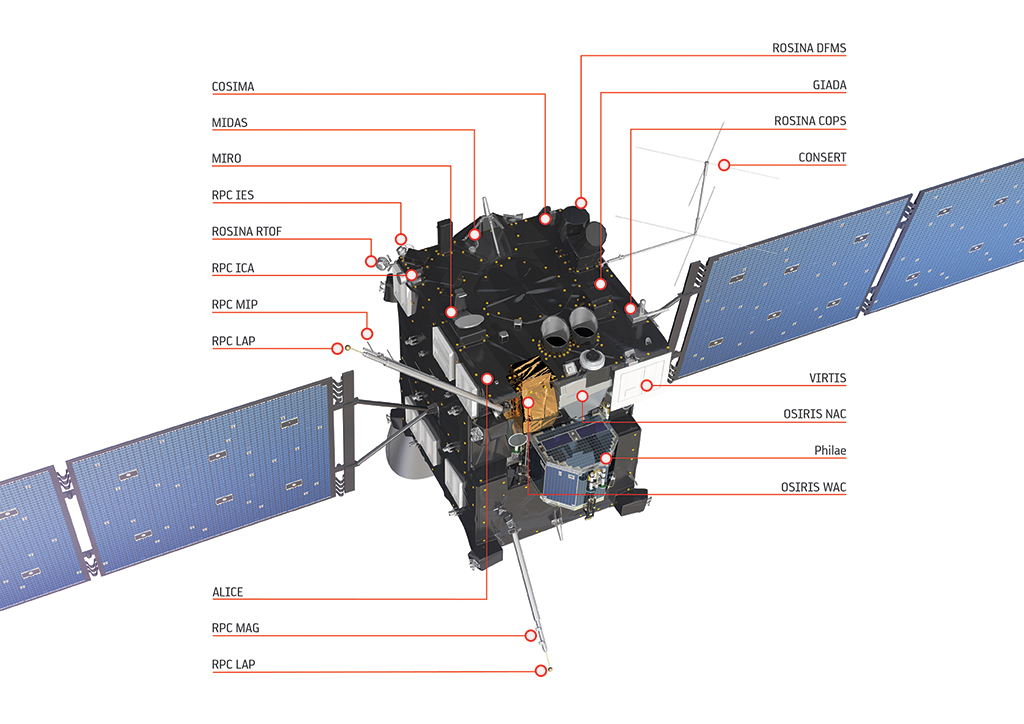The Rosetta Mission
The European Space Agency launched in 2004 the Rosetta mission, consisting of an orbiter and a lander, called Philae, to study the Jupiter-family comet 67P/Churyumov-Gerasimenko. Rosetta is a Horizon 2000 cornerstone mission, involving more than 50 contractors and 14 European countries and the United States. It carries a payload of 15 instruments on the orbiter and 10 instruments on the lander.
 Image: ESA/ATG medialab
Image: ESA/ATG medialab
Our group has a Co-Investigator status on the Rosetta Plasma Consortium ion mass spectrometer ICA (Ion Composition Analyser), built and operated at IRF Kiruna, displayed amognst other instruments in the picture above. We provide modelling support for the plasma instruments through global and local plasma models, utilizing the HYB modelling platform. Below, a global HYB model animation on mass loading around a comet, where solar wind, entering from the right as a blue shroud, collides with cometary ions presented as the yellow-orange density contours.
Rosetta Milestones
- 02 March 2004: Launch
- 04 March 2005: Earth 1st Gravity Assist
- 18 July 2005: Observation of encounter between Deep Impact and comet Tempel 1
- 25 Feb 2007: Mars Gravity Assist
- 14 Nov 2007: Earth 2nd Gravity Assist
- 05 Sept 2008: Asteroid Steins Flyby
- 13 Nov 2009: Earth 3rd Gravity Assist
- 10 July 2010: Asteroid Lutetia Flyby
- 08 June 2011 Aphelion/Enter Hibernation
- 20 Jan 2014: Exit Hibernation
- 07 May 2014: Rendezvous with Comet C-G
- 06 Aug 2014: Start Global Mapping of Comet C-G, distance to comet < 100 km
- Aug-Sept 2014: first evidence of escaping plasma from the comet
- 10 Oct 2014: Global mapping at 10 km distance
- 12 Nov 2014: Landing of Philae, 1 m/s descent speed
- 15 March 2014: Lander ceases to function?
- 13 Aug 2015: Comet 67P/C-G reaches perihelion (1.24 AU)
- 31 Dec 2015: End of nominal mission for Rosetta
Rosetta is a mission for the history books and has gathered many firsts on its 10-year long journey to its target: the first mission to rendezvous with a comet, escort it as it orbits the Sun, and deploy a lander to its surface. The nominal mission is planned until December 2015.
Physical Characteristics of Comet 67P/Churyumov-Gerasimenko (2014-2015)
- Type: Jupiter-family comet
- Perihelion: 1.243 AU
- Aphelion: 5.681 AU
- Period: 6.44 years
- Inclination: 7.04 deg
- Eccentricity: 0.64
- Diameter (nucleus): ~4 km
- Mass: ~1013 kg
- Rotation period: 12.4 h
- Escape velocity: ~1 m/s
- Composition of coma as of 10-2014: H2O, CO2, CO, H, OH, complex molecules (H2S, NH3, CH4, CH3OH, CH2O, HCN, SO2, CS2)
- H2O Outgassing rate: 1025 - 1027 s-1
- Ion outflow in tail: 1023-1026 s-1
- Interaction region: ~105 km
- Discovered: 1969-09-11
- Next perihelion: 2015-08-13
More information on the Rosetta mission, its goals, its history, with hundreds of images and animations, can be found on ESA's website.
Primary Mission Goals
- Rendezvous with comet 67P/Churyumov-Gerasimenko in 2014 and escort it on its way to the inner solar system.
- Characterise in situ the comet's nucleus, interior and associated neutral, dust and plasma coma
- Measure and characterise the increase in cometary activity from distance > 3 AU to perihelion
